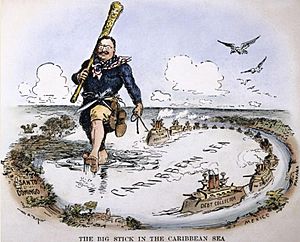Big stick ideology facts for kids

The Big Stick Policy was a way of dealing with other countries, used by U.S. President Theodore Roosevelt. It meant "speak softly and carry a big stick; you will go far." This idea means you should try to talk things out peacefully. But you should also have a strong military ready, just in case peaceful talks don't work.
Roosevelt believed in planning ahead and acting strongly before problems became big crises. His "big stick" approach had a few main parts:
- Have a strong military, especially a powerful navy, so other countries would listen.
- Always act fairly towards other nations.
- Never make threats you can't follow through on.
- Only use force when you are fully prepared to do so.
- Allow the other side to back down without losing all their pride.
This policy is similar to gunboat diplomacy. That's when a country uses its navy to threaten or pressure another country.
Contents
How the Idea Started
The phrase "speak softly and carry a big stick" was first used by Theodore Roosevelt in a private letter in 1900. At the time, he was the Governor of New York. He wrote it after successfully dealing with a difficult political situation.
He later used the phrase publicly in a speech in 1901 at the Minnesota State Fair. Just a few days after this speech, President William McKinley was shot. When McKinley died, Roosevelt became president.
Using the "Big Stick"
Even though Roosevelt used the phrase before becoming president, he put the "big stick" idea into action many times during his presidency. He used the military in a subtle way to support his diplomatic plans. He also used it to enforce the Monroe Doctrine in Latin America.
One example was the Great White Fleet. This was a group of 16 U.S. Navy battleships. They sailed around the world peacefully. This showed the growing power of the United States without actually fighting anyone.
In Latin America
The Venezuelan Problem (1902) and the Roosevelt Corollary
In the early 1900s, countries like Britain and Germany were upset with Venezuela. Venezuela owed them money and had caused problems for their citizens. So, the British and German navies blocked Venezuelan ports.
Roosevelt didn't like this European interference in the Americas. This situation led to the Roosevelt Corollary to the Monroe Doctrine. The Monroe Doctrine had warned European powers not to colonize or interfere in the Americas. The Roosevelt Corollary added to this. It said that the United States would act as an "international police power" in Latin America. This meant the U.S. would step in if Latin American countries couldn't manage their own affairs or pay their debts. Roosevelt said this was to help these countries be "happy and prosperous."
During the blockade, Roosevelt sent U.S. naval forces to Cuba. This was to show that the U.S. was serious about the Monroe Doctrine. The Roosevelt Corollary was a big change in U.S. foreign policy.
Building the Panama Canal
The U.S. also used the "big stick" when it wanted to build a canal across Central America. This was called "Canal Diplomacy."
The Panama Canal
The U.S. wanted to build a canal to connect the Atlantic and Pacific Oceans. This would make trade and travel much faster. After looking at Nicaragua, Panama was chosen as the best place. At the time, Panama was part of Colombia.
Colombia and the French company that owned the canal rights asked for a lot of money. The U.S. didn't want to pay the higher prices. So, the U.S. supported a revolution in Panama. On November 3, 1903, Panama declared its independence from Colombia. The United States Navy helped protect the new Panamanian government.
Panama became an independent country. It received money from the U.S. and guarantees of its independence. In return, the U.S. gained control of the Panama Canal Zone forever. Roosevelt later famously said that he "took the Canal, and let Congress debate."
Cuba
After the Spanish–American War, the U.S. had to decide what to do with Cuba. Many Americans wanted to take control of Cuba. However, the Teller Amendment had been passed. This amendment said that the U.S. would not try to control Cuba. It promised to leave the island's government to its people after peace was restored.
But some people argued that the U.S. still needed to protect its interests in Cuba. This led to the Platt Amendment in 1901. This amendment was added to a U.S. Army funding bill. Cuba accepted it after a lot of pressure from the U.S.
The Platt Amendment meant several things for Cuba:
- Cuba could not make agreements with other countries that would hurt its independence.
- Cuba could not go into too much debt, which might lead to other countries interfering.
- The United States could step in to keep order and protect Cuba's independence.
- Cuba had to agree to a U.S.-supported health program, especially for diseases like yellow fever.
- Cuba had to sell or lease land to the U.S. for naval bases, like Guantánamo Bay.
Once the Platt Amendment was in place, Roosevelt pulled U.S. troops out of Cuba.
|
See also
 In Spanish: Gran Garrote para niños
In Spanish: Gran Garrote para niños



